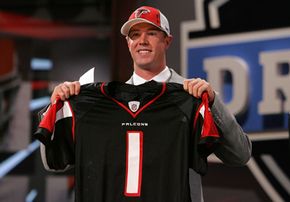Teams begin assessing the abilities of college players months if not years prior to the NFL draft. Scouts, coaches, general managers, and sometimes even team owners compile statistics and notes in their evaluation of hundreds of college football's best players before they make their selection.
The NFL Scouting Combine in February is another chance for teams to get familiar with the players. The combine is an annual event where more than 300 of the top draft-eligible players are invited to showcase their abilities. The combine is also when the media and fans begin focusing their attention on draft day.
After assessing the players, teams will make their wish lists for the players they want to draft. Then they determine their alternative selections because, unless a team has the top two or three picks in the draft, drafting any particular player is not guaranteed.
Mr. Irrelevant
Just as someone has to be the first pick in the draft, someone has to be last. This player is given the dubious moniker of Mr. Irrelevant. Although it sounds insulting, there are hundreds of players who wish they were in this player's shoes.
Mr. Irrelevant is actually the most celebrated player outside of the first round. In fact, he is the only player in the draft to have a formal celebration thrown in his honor. In 1976 Paul Salata, a former receiver for the Baltimore Colts, arranged an annual event in Newport Beach, CA, called Irrelevant Weekto celebrate the last player selected in each draft.
After being flown to California, Mr. Irrelevant is paraded through Newport Beach. He'll then spend the next week going to Disneyland, attending a baseball game, and other activities. Each Mr. Irrelevant also receives the Lowsman Trophy, a small bronze statue of a player fumbling a ball. The Lowsman is the antithesis of the Heisman Trophy, which is given annually to the best player in college football.
On draft day, the team's key personnel huddles together in a room, known as the War Room. It's in this room that the decision is made about whom to draft. The selection is then relayed to a team representative, who submits the selection to an NFL official such as the commissioner, who then announces the selection.
Some teams, especially those with a high draft selection, may determine their first-round selection far in advance of the draft and may even have settled on contract terms with the player. In this case, the draft is just a formality, and the player need only sign the contract to make it official.
Once the draft begins, teams pay close attention to the selections made by the teams ahead of them in the draft order. Sometimes, a team that has already determined its selection may have to scramble to pick someone else because the player it wanted was unexpectedly drafted by another team.
In the next section, we'll outline who is eligible to be drafted, and we'll take a look at the draft experience from a player's perspective.
